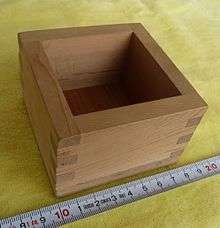Gō (unit)
| Look up gō in Wiktionary, the free dictionary. |

The gō (合) is a traditional Japanese unit of area and volume. It expresses a tenth of a particular quantity.
As a unit expressing area, one gō is equivalent to a tenth of a bu or tsubo. This is approximately equal to 0.3306 m².
As a unit expressing volume, one gō is equivalent to a tenth of a shō. This is approximately equal to 0.1809 liters.
Although it is no longer used officially, rice and sake are often measured in gō. For example, rice cookers come with a 1 gō (180 mL) measuring cup used to indicate the serving size for one person. As a rule of thumb, one gō is equivalent to about 150 grams of Japanese short grain rice. A gō is 1/1000 of a koku, the base unit which was historically defined as the amount of rice needed to feed one person for a year. It is a very old unit of measurement and recently there has been some attempts of revival which have met with success; several more things are now being measured in gō like traditional Japanese fish (especially the dangerous fugu) and several restaurants have re-instated it as part of a more traditional way of viewing the country's culture.
The Japanese gō is distinct from the Chinese unit gě, although both are written with the same character. The gě is also a unit of volume, but its size is a tenth of a peck, or roughly 0.881 liters.